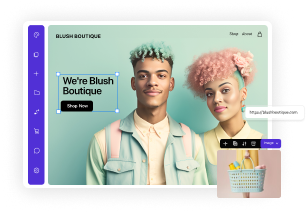How To Format A Blog Post In 2025: A Step-By-Step Guide
Updated Aug 20, 2025 | Published Apr 30, 2025 | 11 min read

A well-designed blog format creates a reading experience that naturally guides readers through your content. Millions of blog posts get published daily, so the structure and presentation of your content can make it stand out from the crowd.
In the early days of blogging, simple text organization was the norm. Nowadays, blogs utilize responsive design, strategic image placement, and reader-friendly layouts to entice and engage visitors.
Our step-by-step guide on how to format a blog post covers everything you need to know to maximize its impact.
Properly formatting your blog posts is crucial, whether you’re just starting as a freelance writer or want to refresh your own blog. Understanding the key factors that influence an effective blog format is essential.
Your formatting choices must adapt to current reader preferences and technological trends. Your blog’s visual presentation is just as important as its content and can give a different perspective to your blog.
First and foremost, consider your target audience and their reading habits. Most people scan content rather than reading word-for-word, so creating a format that supports this behavior is crucial.
Breaking text into digestible chunks makes your content easier to read and less intimidating, especially on mobile devices.
Accessibility is crucial, and your blog format should be designed to accommodate visitors with diverse abilities and preferences. To improve accessibility, use clear headings, provide alt text for images, and ensure sufficient color contrast in your design elements.
Search engine optimization (SEO) also plays a vital role in formatting decisions. Proper use of headings, subheadings, and formatting elements can help your blog post rank higher.
Smart formatting choices can enhance your content’s visibility in search results, increasing your blog’s organic traffic. Create a blog post checklist to ensure you cover all the essentials when formatting your blog.
Blogs are a content marketing strategy that creates valuable, relevant, consistent content to attract and retain a clear target audience. Part of that content marketing strategy involves creating a well-formatted blog post.
By following this 10-step guide to formatting a blog, you’ll learn to create visually appealing content that is easy to navigate and makes sense to readers.
The foundation of a good blog format starts with selecting the right template for your content. A user-friendly template provides the structure you need while allowing sufficient flexibility to customize your content.
The latest blogging platforms offer a range of templates specifically designed for bloggers. You can use these resources to arrange ideas comprehensively that will eventually form the basis of your blog posts.
Look for clean designs and ample white space templates, as this helps make your content more readable. A good template should prioritize readability, with clear font choices and a logical content flow.
Consider how the template displays on different devices. It should look equally good on desktop computers, tablets, and smartphones.
Many templates now feature built-in enhancements that improve the reader experience. These can include table of contents widgets, progress bars, and social sharing buttons.
Don’t be afraid to test different templates to find the one that best showcases your content and brand style.
Choose your design layout: Explore Friday templates.
Do keyword research to understand what’s trending and ensure you’re using a captivating headline. Your blog title or header is the first thing visitors see, making it a crucial element of your blog’s format.
With attention spans shorter than ever, your blog title must immediately grab attention and communicate what readers will get from your post. A compelling header can significantly increase your click-through rates.
Craft page titles and headlines that are specific, useful, and create a sense of urgency or curiosity. Including numbers (like “10 Ways to…” or “5 Steps to…”) makes your content more digestible.
Keep your headlines to 70 characters or less to ensure they display properly in search results and on social media. Consider using headline analyzer tools to evaluate the effectiveness of your headlines before publishing.
Think of a headline as a brief description of each section of your writing. Remember that even the most beautifully formatted blog post will not be read if the headline doesn’t convince readers to click through.
Font selection is a subtle yet powerful aspect of a good blog post that impacts how readers experience your writing. Readability is paramount, so choose readable fonts that are easy on the eyes, especially when viewed on smaller screens.
Pay attention to font size; your body text should be at least 16px for comfortable reading on most devices. Whatever font size you choose for your writing, ensure consistency by sticking to it.
The right font size and style can keep readers engaged longer and prevent straining that might cause them to abandon your article. Stick to a maximum of two fonts in your writing, typically one for headings and one for body text.
Sans-serif fonts, such as Arial, Helvetica, or Open Sans, work well for body text because they’re clean and readable at smaller sizes. You might choose something with more personality for headings, but make sure it remains legible.
Line and paragraph spacing also contribute to overall readability, ensuring sufficient breathing room between lines and paragraphs. Research some of the most popular blogs for inspiration using different fonts and blog post formats.
More than 90% of internet users access content via mobile devices, making responsive design necessary for effective blog formatting. Responsive design ensures that your blog looks great and functions well, regardless of the device or screen size.
Select blogging platforms and templates built with responsive design principles. These will automatically adjust your layout, image sizes, and navigation elements to provide the best experience on any device.
Test your blog posts on multiple devices before publishing to identify any formatting issues that may affect mobile readers. Mobile users interact with content differently; they’re more likely to scroll with their thumbs and may have slower internet connections.
Keep sentences short for mobile readers, use ample white space, and ensure buttons and links are easy to tap on a touchscreen. Keeping paragraphs short—no more than two or three sentences—will make your writing more accessible to all readers.
Build your blog on Friday.
Headings and subheadings are critical elements in an effective blog format. They provide key information and serve as signposts that guide readers through your content, breaking up intimidating walls of text.
A proper heading structure makes your content more accessible and improves SEO. It helps search engines understand the information hierarchy within your article.
Use the correct heading tags, for example, H1 for your main title, H2 for major sections, H3 for subsections, and so on. Each heading should accurately describe the content and incorporate specific keywords naturally where appropriate.
Well-crafted headings make it easier for readers to return to your article later and find specific information they remember.
The future of blogging has been questioned with the advent of artificial intelligence (AI). However, articles written by real people, with a hierarchical structure that creates a logical flow, continue to resonate more deeply with readers and often perform better than AI-generated articles.
Readers rarely read content word by word; instead, they scan pages for relevant information. Your blog format should accommodate this behavior by helping readers skim your content more easily.
Well-structured content helps readers quickly locate the information they need, increasing the time they spend on your page. You can use a visual hierarchy to guide readers through your content, making clear distinctions between different levels of information.
Break up long text sections with subheadings, bullet points, numbered lists, and short paragraphs. Each paragraph should focus on a single idea or point to make your content easier to digest.
Consider using formatting elements like bold text, italics, or highlighted sections to emphasize key points. Pull quotes or callout boxes can also draw the reader’s attention to important information.
Visual elements are no longer optional but essential for enhancing engagement and clarifying concepts. Featured images, infographics, charts, or videos can significantly increase the time someone interacts with your content.
Strategic use of visuals can increase comprehension by up to 400%. Add images where they naturally complement your text, rather than scattering them randomly throughout your article.
Each visual should serve a purpose, whether it illustrates a concept, is part of a how-to post, breaks up text, or provides additional information. Always add alt text to images to improve accessibility and search engine optimisation.
If your article was originally published elsewhere, you can adapt it for use as a blog post. This is where multimedia elements, such as videos, audio clips, or infographics, can be incorporated to enhance and enrich the blog post.
Two blog posts on the same topic can appear quite different when utilizing various media types.
Highlighting key takeaways throughout your post helps readers quickly identify the most valuable information. Strategic highlighting keeps your main message front and center for readers with limited time.
Consider using colored backgrounds or bordered sections to emphasize important points or summaries. These visual cues signal to readers that the information contained within is particularly valuable or actionable.
Another effective technique is to include a “Key Takeaways” or “TL;DR” (Too Long; Didn’t Read) section at the beginning or end of your article. This summary serves as a guide for readers who want to grasp the main points without having to read the entire article.
Whether you blog as a side hustle or write a blog for a living, every blog post should guide readers toward the next step. Make calls-to-action essential elements of your blog post, whether that is to subscribe, share content, or read related posts.
Well-designed CTAs can significantly boost conversion rates. Place your primary CTA where it makes the most sense in the context.
Consider including additional CTAs at natural breaking points throughout the content for longer posts. Use buttons, colored boxes, or special formatting to make your CTAs visually appealing from the surrounding content.
Use action-oriented language that tells readers what you want them to do and why it benefits them. Remember to limit the number of different calls-to-action (CTAs) to avoid overwhelming readers.
Strategic linking is an often-overlooked aspect of an effective blog post format. It adds depth to your content while improving Search Engine Optimization.
Add links to other blog posts on your own site to help readers discover more information and keep them engaged. External links to reputable sources demonstrate your research and add credibility to your claims.
Incorporate relevant links naturally within your writing, and use anchor text to give visitors a clear idea of what you’re linking to. Avoid generic phrases like “click here” and opt for more specific descriptions instead.
Thoughtful linking adds more value for readers while strengthening your site’s overall structure.
Consider grouping related internal links in a “Related Posts” section at the end of your blog post. This action provides clear next steps for readers who wish to explore a blog topic in more detail.
For external links to other pages or leadership posts that aren’t essential to understanding your content, make sure they open in new tabs. This way, your visitors can navigate away from your site without leaving it completely.
Following the steps outlined in our guide should give you a clear understanding of how your blog posts can stand out. The most effective blog format prioritizes readers, making it easy for them to read and act on your content.
While trends and technologies continue to evolve, a reader-centric approach will always remain at the heart of the most successful blogs.
Whether you’re writing your own blog or contributing a guest post, learning how to format a blog post properly is key to delivering clear and engaging content every time.
